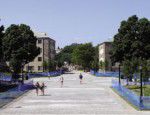New Quad combines form, function

September 6, 2002
While many students see the newly renovated Quad as a recreational haven for sophomores, the area’s designers and the Pennsylvania Department of Environmental Protection (PaDEP) think its underlying design could play a major role in the future of water conservation in the Northeast.
Whereas conventional drainage systems direct rainwater away from local groundwater supplies and toward major bodies of water, the Quad’s drainage system uses a porous concrete to absorb water and direct it into the surrounding soil. According to Leo Kob, the Facilities Management Office’s project manager for the Quad, this type of system has been used in warmer climates for many years but has not been tried further north because of the more extreme seasonal changes.
Most of the other changes made to the Quad area this summer were aesthetic: the asphalt driveway was replaced by a pedestrian walkway, new sod was laid and trees and bushes were planted.
Additionally, handrails and instruments to monitor the drainage system were installed during the past few weeks.
According to Kob, the Quad redesign is part of plan to have a large pedestrian walkway through campus and to reduce the number of vehicles on main campus.
The largest student complaint about the renovated Quad deals with the color and texture of the porous concrete. Junior Jeremy Finn, a former Quad resident, said, “I think it’s kind of foolish to do so much work on the Quad and not make the concrete look nice. A job worth doing is a job worth doing right.”
Kob said the late patching of the concrete caused many of the color differences, one of the issues which Facilities Management will address in a meeting today.
Preliminary infrastructure work on the Quad began towards the end of spring 2001, and pathways for a handicapped entrance to Connelly Plaza were installed during last year’s spring break. According to Kob, the Quad reconstruction did not really begin until after last year’s graduation.
Despite the fact that sod had not been laid and some of the bushes had not been planted, Kob officially declared the project finished on the Friday before start of classes. Last week’s rainfall allowed Facilities Management to complete the plantings.
The final cost for the Quad’s reconstruction tallied approximately $500,000 which, according to Kob, was slightly over budget. He indicated that the University may share some of the costs with the contractor because he was unfamiliar with the type of concrete.
The idea for redesigning the Quad originated in 1998 as a result of the Bartley Hall renovations when an architect’s rendering of Bartley depicted a greener pedestrian Quad lined with bushes and speckled with trees.
Early last year, Kevin O’Donnell, superintendent of grounds for Facilities Management, assembled a Quad committee which met monthly to discuss functions that the area could and would have to serve, such as trash collection, student move-in , undergraduate recreational activities and the needs of the College of Commerce and Finance.
Approximately halfway through the redesign process, Dr. Robert Traver of the Civil and Environmental Engineering Department approached the committee, proposing the University incorporate a porous concrete drainage system into the renovation plans.
He indicated that conventional drainage systems divert rainwater away from suburban areas, contributing to groundwater shortages and worsening drought conditions. According to Traver, the porous concrete system, developed in conjunction with the PaDEP, returns water directly to local aquifers.
After a review of Traver’s proposal, the Facilities Management Office decided to include the new drainage system in the reconstruction design. Traver says that with this system, “Drainage from the roof, the green areas and the Quad itself is now infiltrated back into the ground.” He continued, “I was out there in the rain this weekend and [the porous concrete] worked great.”
When rain falls, the concrete absorbs the water and drains it into 6-foot-deep basins having a total surface area of 10,000 square feet. From these the water is directed into the surrounding soil.
While this new technology has many potential environmental benefits, it also poses some unique challenges. “We’re pushing the envelope on the durability and strength of the materials,” Kob said. He indicated that the concrete is usually used for walkways, but in the Quad it will have to carry heavier loads, including cars and trucks. The concrete layer was made thicker than it normally is to accommodate the extra weight.
Also, the University does not know how well the porous concrete will react to the cold weather because it has never been used this far north.
Kob said there is a safety valve if the challenges prove too great and the drainage system does not work. The conventional drainage system between the Quad and Bartley Hall is sufficient to handle all the runoff.
The new drainage system was partially funded through a grant awarded to Traver by PaDEP. The grant covered $6,000 of the engineering and design expenses and $47,250 of the construction costs. PaDEP is also monitoring the functionality of the system.
If the University’s trial of the drainage system is successful, Kob believes that it could see more widespread use over the Northeast.
“We expect this to be used all over suburban areas in the next few years,” he said.










